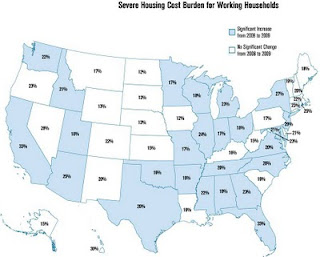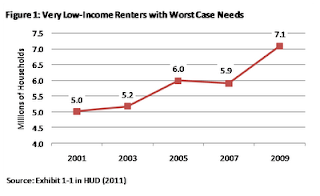Jeffrey Lubell, Executive Director of the Center for Housing Policy, testified before Congress today about housing affordability trends. Below are his full written remarks which can also be found on the National Housing Conference website.
Housing affordability is often a concern for renters with the lowest incomes. There were approximately 17.1 million very low-income renters in 2009, and a recent study by the U.S. Department of Housing and Urban Development (2011) found that:
- 7.1 million (41 percent) had worst case needs, spending more than half of their income on housing costs, living in substandard housing, or both, without receiving government rental assistance.
- The number of renters with worst case needs has increased by nearly 42 percent since 2001. Between 2007 and 2009, the number rose by 1.2 million households – or 20 percent. A two-year increase of this magnitude is unparalleled in at least the last 25 years.
- Only 60 affordable and adequate units were available for every 100 very low-income renters in 2009.
- Increased competition for affordable units, falling incomes, and a shortage of rental assistance are the primary factors driving the recent increase in worst case needs.
- In 2009, families with children made up 39 percent of all renters with worst case needs, representing the most common household type. However, renters with worst case needs are far from homogenous, representing all household types, races/ethnicities, and residential settings.
Low- and Moderate-Income Working Families
But housing affordability concerns are not limited to very low-income renters. Another recent study – this time by the Center for Housing Policy – found high levels of severe housing cost burden among working families – both renters and owners – spanning a broad income range. In 2009, there were 46.2 million households in the United States that averaged at least 20 hours per week in the workplace and earned no more than 120 percent of the area median income. Our study (Wardrip 2011) found that:
- Nearly one in four working households had a severe housing cost burden in 2009, spending more than half of their income on housing. More than 10.5 million working households experienced this cost burden – an increase of 600,000 households in only one year.
- The share of working households with a severe housing cost burden increased significantly in 25 states between 2008 and 2009, while no states saw a statistically significant decrease.
- Roughly 80 percent of working households with extremely low incomes (below 30 percent of the area median income) had a severe housing cost burden. However, housing costs burden working households of all incomes and tenures, from coast to coast.
- Working renters reported working fewer hours in 2009 than in 2008, and nominal household incomes declined by 4 to 5 percent for working renters and owners.
Rural Housing Challenges
Housing issues in rural America are often over-shadowed in policy discussions, but one-fifth of all U.S. households live in rural communities. Many of the same housing concerns associated with urban areas are also of concern in rural areas.
- Roughly 3.4 million households in non-metropolitan areas spent half or more of their income on housing in 2009. Approximately 40 percent were renters.
- Although housing quality in rural areas has improved markedly during the last several decades, it remains an issue for many. According to data collected in 2009, approximately 1.5 million rural households lived in substandard housing (Housing Assistance Council 2010).
- Among the 3.1 million very low-income renters in non-metropolitan America, some 1.1 million – or 36 percent – had a worst case need in 2009, either spending more than half of their income on housing costs or living in severely inadequate conditions. This rate is close to that of renters with similar incomes in central cities and the suburbs (42 to 43 percent) (HUD 2011).
- Despite lower housing costs generally, rural areas lack a sufficient number of units for their very low-income renters. Fewer than 73 units were affordable, available, and adequate for every 100 very low-income renters in nonmetropolitan areas in 2009 (HUD 2011).
Homelessness
Even in the best economic times, a substantial number of families and individuals go to bed each night without a permanent roof over their heads. The sagging economy and persistently high unemployment rate have not only eroded housing affordability for those with homes of their own but also made it increasingly difficult to address homelessness.
- The number of people who were homeless on a given night in 2009 increased by 3 percent from 2008 to 2009, rising to approximately 656,129. The homeless population increased in 30 states and the District of Columbia (Sermons and Witte 2011).
- Over 1.5 million people used the shelter system during the 12 months ending September 30, 2009 (HUD 2010). Although the number of people seeking shelter has inched down over the last two years (-1.9 percent), the number of households with children doing so has increased from 131,000 to 170,000 over the same time period (HUD 2010).
- The population living in doubled-up situations for economic reasons – a common living arrangement prior to homelessness – rose to over 6 million people in 2009, an increase of almost 12 percent in one year (Sermons and Witte 2011).
Multifamily Housing Markets
Much of the nation’s affordable housing (whether assisted or unassisted by government subsidies) is in multifamily properties. This sector is still recovering from the effects of the recession and the capital market disruptions, so affordability challenges will persist. The lack of financing and uncertainty about future demand greatly slowed the pace of new apartment construction, the effects of which will persist for at least 1-2 years. A recent Marcus & Millichap (2011) report expects only 53,000 new apartment completions in 2011, down 46 percent from last year and far less than the expected 158,000 new units demanded. In general, the renting of foreclosed single-family homes does not significantly offset the shortage of new apartments—these houses are priced higher, more costly to maintain, in inconvenient locations for renters, and difficult to manage efficiently as rental properties.
Reliable capital flows are still a barrier to sustained multifamily production as well. Debt capital is still primarily government backed, with the GSEs and FHA providing more than 90% of new originations. Equity investment interest is once again growing due to projections of rising demand and stronger yields. Demand for Low Income Housing Tax Credits (LIHTC) has rebounded somewhat from the devastating retreat of equity capital in 2008-9, although demand and pricing are generally substantially below their peak. Properties in stronger, mostly coastal housing markets command far more investor interest than other areas.
Impact of Rising Energy Prices
Living costs are not limited to the costs of shelter. Families also must may for utility costs as well as the transportation costs of getting to and from work and around town. Research conducted by the Center for Housing Policy and the Center for Neighborhood Technology found that moderate-income working families (incomes of $20,000 to $50,000 in 2000) in the 28 metro areas studied actually spent slightly more for transportation (30% of income) in 2000 than their combined housing and utility costs (28% of income), with the costs for both heavily dependent on how close they lived to jobs and public transportation. (Lipman 2006). Cities like New York City, with high housing costs, often had comparatively low transportation costs, while cities like Houston and Cincinnati, with low housing costs, often had comparatively high transportation costs.
While updated data on the combined burden of housing, transportation and utility costs will not be available until next year, one thing is clear: Low- and moderate-income families are highly vulnerable to rising energy prices. Everyone will pay more in utility costs as energy prices rise, reducing affordability even further. Families that live far from their places of employment and in auto-dependent communities will bear a double burden as their transportation costs rise along with their utility costs.
Conclusion
Housing prices have fallen sharply over the past several years. For those buying a home today, affordability has certainly improved. However, affordability has not improved for America’s renters and owners more generally. For renters as well as homeowners who stay in place, monthly housing costs have largely remained stable or risen, while unemployment and under-employment have reduced incomes for many. The rising demand for low-cost units and the sharp drop-off of multifamily production in recent years have exacerbated the already significant shortage of affordable and available units. In short, far from improving it, recent economic and housing market trends have significantly worsened housing affordability for America’s low- and moderate-income households. Rising energy prices will likely further exacerbate families’ affordability challenges in the years to come.




